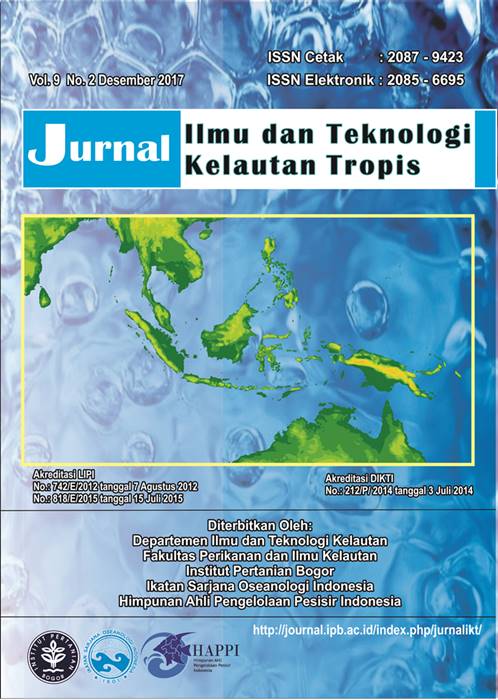NUTRITIONAL VALUE AND HEAVY METALS CONTENTS OF THE DRIED SEA CUCUMBER Stichopus vastus FROM SALEMO ISLAND, INDONESIA
Abstract
The dried sea cucumber Stichopus vastus is one of the commercially species harvested in Indonesian waters. This study aims to highlight the nutritional value and heavy metals content of dried sea cucumber S. vastus. Proximate (moisture, ash, protein, fat and carbohydrate), mineral (sodium, calcium, potassium and iron) and heavy metal (mercury, cadmium, arsenic and lead) were determined by standard method of AOAC, while phosphorous was determined by spectrophotometric method. Chondroitin sulphate was determined by UPLC method, glucosamine sulphate and vitamin (A, B1, B2 and E) by HPLC method. Results show that protein was the major component in proximate analysis of dried sea cucumber S. vastus in the present study. The protein content was 38.70%. Moisture, ash, fat and carbohydrate content were 19.46%, 34.04%, 0.38% and 7.42% respectively. All vitamins and heavy metals examined in this study were not detected. The sodium content was 8054.36 mg/100 g higher than other minerals. Calcium, potassium, phosphorus and iron content were 2449.9 mg/100 g, 159.77 mg/100 g, 5085.2 mg/100 g and 520.8 mg/100 g respectively. Glucosamine sulphate content was found to be 2.429 g/100 g, whereas chondroitin sulphate was found to be 1.115 g/100 g. It can therefore, be concluded that the dried sea cucumber S. vastus from Salemo Island is safe for human consumption and hence can be used as a source of food supplement in the future.
Keywords: food supplement, Salemo island, Stichopus vastus
Authors
This work is licensed under a Creative Commons Attribution 4.0 International License.
Jurnal Ilmu dan Teknologi Kelautan Tropis i is an open-access journal, meaning that all content is freely available without charge to the user or their institution. Users are allowed to read, download, copy, distribute, print, search, or link to the full texts of the articles in this journal without needing to request prior permission from the publisher or the author.
All articles published by Jurnal Ilmu dan Teknologi Kelautan Tropis are licensed under the Creative Commons Attribution 4.0 International License. This allows for unrestricted use, distribution, and reproduction in any medium, provided proper credit is given to the original authors.
Authors submitting manuscripts should understand and agree that the copyright of published manuscripts is retained by the authors. Copyright encompasses the exclusive rights of authors to reproduce, distribute, and sell any part of the journal articles in all forms and media. Reproduction of any part of this journal, its storage in databases, and its transmission by any form or media is allowed without written permission from Jurnal Ilmu dan Teknologi Kelautan Tropis.


